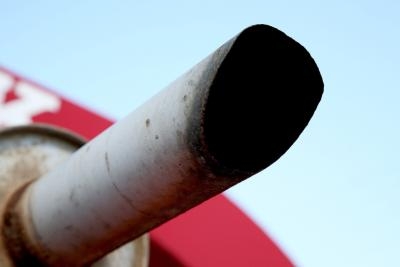
A lot depends on the exhaust system on your vehicle, since it must expel spent gases from your internal combustion engine. Unrestricted exhaust flow and balance determine how well the vehicle "exhales" and gets rid of the hot internal gases. Some pipe designs and diameters work best for certain engine sizes and horsepower. When replacing exhaust pipes, the owner should know some standard rules for pipe size and horsepower. Excessively large pipes are unnecessary and retard complete combustion. Too-small exhaust pipes can cause unwanted back-flow and choking, which causes poor performance and inferior fuel economy.
Place your vehicle in "Park" for an automatic transmission. Set it in "Neutral" for a manual transmission. Apply the emergency brake. Use a floor jack to raise the vehicle front and rear, and place two jack stands under each side of the frame. Slide under your vehicle with a tape measure or outside micrometer. Examine the exhaust system to make sure all of the exhaust pipes have the same uniform size, whether single exhaust or dual exhaust.
Wrap the tape measure around the outside of the exhaust pipe and write down the number. Take the total in inches and divide that number by 3.14 to arrive at your pipe diameter. If using an outside micrometer, slip the tongs of the gauge over the widest part of the pipe and adjust the dial. Read the micrometer in inches and fractions. Some common diameter types include 2 1/4-inch, 2 1/2-inch and 3-inch.
Consult your owner's manual for the exhaust pipe diameter dimensions of your vehicle. Compare your physical measurement to what the book recommends. If the numbers match, it means your vehicle has the manufacturer's standard exhaust. Consider this match to be the best fit for your vehicle.
Consult your owner's manual and note your engine's horsepower rating. To calculate the approximate minimum and maximum allowable exhaust pipe diameters, for any type of an exhaust system change, you can refer to a chart.
Use 1 1/2-inch pipe for an engine that has 78 horsepower for a single exhaust, or 155 horsepower for dual exhaust. Use 1 5/8-inch pipe for a 92 horsepower single exhaust; 185 horsepower for dual exhaust. Use 1 3/4-inch pipe for a 108-horsepower single exhaust or 217-horsepower dual exhaust.
Use 2-inch pipe for a 144-horsepower single exhaust or 289-horsepower dual exhaust system. Use 2 1/4-inch pipe for a 185-horsepower single exhaust or 371-horsepower dual exhaust. Use 2 1/2-inch pipe for 232-horsepower single exhaust or 463-horsepower dual exhaust.
Use 2 3/4 pipe for 283-horsepower single exhaust or 566-horsepower dual exhaust. Use 3-inch pipe for 339-horsepower single exhaust or 679-horsepower dual exhaust. Use 3 1/4-inch pipe for 401-horsepower single exhaust or 802-horsepower dual exhaust. Use 3 1/2-inch pipe for 468-horsepower single exhaust or 935-horsepower dual exhaust.